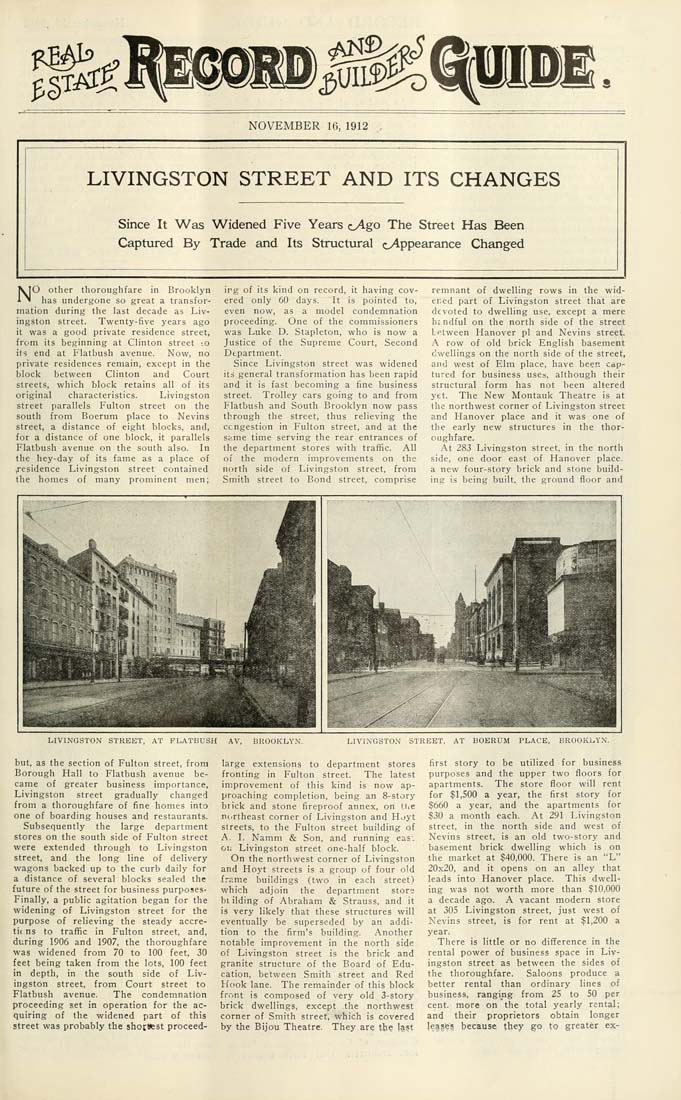Columbia University Libraries Digital Collections: The Real Estate Record
Use your browser's Print function to print these pages.
Real estate record and builders' guide: [v. 90, no. 2331]: November 16, 1912

Text version:
Please note: this text may be incomplete. For more information about this OCR, view About OCR text.
NOVEMBER 16, 1912 LIVINGSTON STREET AND ITS CHANGES Since It Was Widened Five Years zAgo The Street Has Been Captured By Trade and Its Structural c^ppearance Changed No other thoroughfare in Brooklyn has undergone so great a transfor¬ mation during the last decade as Liv¬ ingston street. Twenty-five years ago it was a good private residence street, from its beginning at Clinton street lO its end at Flatbush avenue, Noav, no private residences remain, except in the block between Clinton and Court streets, Avhich block retains all of its original characteristics. Livingston street parallels Fulton street on the south from Boerum place to Nevins street, a distance of eight blocks, and, for a distance of one block, it parallels Flatbush avenue on the south also. In the hey-day of its fame as a place of residence Livingston street contained the homes of many prominent men; irg of its kind on record, it having cov¬ ered only 60 days. It is pointed to, even now, as a model condemnation proceeding. One of the commissioners was Luke D, Stapleton, who is now a Justice of the Supreme Court, Second Department. Since Livingston street vcas widened its general transformation has been rapid and it is fast becoming a fine business street. Trolley cars going to and from Flatbush and South Brooklyn now pass through the street, thus relieving the congestion in Fulton street, and at the same time serving the rear entrances of the department stores with traffic. All of the modern improvements on the north side of Livingston street, from Smith street to Bond street, comprise remnant of dwelling rows in the wid¬ ened part of Livingston street that are devoted to dwelling use, except a mere handful on the north side of the street between Hanover pl and Nevins street, A row of old brick English basement dwellings on the north side of the street, and west of Elm place, have been cap¬ tured for business uses, although their structural form has not been altered yet. The New Montauk Theatre is at Ihe northwest corner of Livingston street and Hanover place and it was one of the early new structures in the thor¬ oughfare. At 283 Livingston street, in the north side, one door east of Hanover place, a new four-story brick and stone build¬ ing is being built, the ground floor and LIVINGSTON STREET, AT FLATBUSH AV, BROOKLTN, LIVIXOSTO.-^ STREET, AT BOERUM PLACE, BROOKLYN. but, as the section of Fulton street, from Borough Hall to Flatbush avenue be¬ came of greater business importance. Livingston street gradually changed from a thoroughfare of fine homes into one of boarding houses and restaurants. Subsequently the large department stores on the south side of Fulton street were extended through to Livingston street, and the long line of delivery wagons backed up to the curb daily for a distance of several blocks sealed the future of the street for business purposes- Finally, a public agitation began for the widening of Livingston street for the purpose of relieving the steady accre- ti< ns to traffic in Fulton street, and, during 1906 and 1907, the thoroughfare Avas widened from 70 to 100 feet, 30 feet being taken from the lots, 100 feet in depth, in the south side of Liv¬ ingston street, from Court street to Flatbush avenue. The condemnation proceeding set in operation for the ac¬ quiring of the widened part of this street was probably the shoftfest proceed- large extensions to department stores fronting in Fulton street. The latest improvement of this kind is now ap¬ proaching completion, being an 8-story brick and stone fireproof annex, on the northeast corner of Livingston and Hoyt streets, to the Fulton street building of A, I. Namm & Son, and running eas. OI; Livingston street one-half block. On the northwest corner of Livingston and Hoyt streets is a group of four old frame buildings (two in each street) which adjoin the department store biilding of Abraham & Strauss, and it is very likely that these structures will eventually be superseded by an addi¬ tion to the firm's building. Another notable improvement in the north side of Livingston street is the brick and granite structure of the Board of Edu¬ cation, between Smith street and Red Hook lane. The remainder of this block front is composed of very old 3-story brick dwellings, except the northwest corner of Smith street, which is covered by the Bijou Theatre. They are the l^st first story to be utilized for business purposes and the upper two floors for apartments. The store floor will rent for $1,500 a year, the first story for $660 a year, and the apartments for $30 a month each. At 291 Livingston street, in the north side and west of Nevins street, is an old two-story and basement brick dwelling which is on the market at $40,000, There is an "L" 20x20, and it opens on an alley that leads into Hanover place. This dwell¬ ing was not worth more than $10,000 a decade ago. A vacant modern store at 305 Livingston street, just west of Nevins street, is for rent at $1,200 a year. There is little or no difference in the rental power of business space in Liv¬ ingston street as between the sides of the thoroughfare. Saloons produce a better rental than ordinary lines of business, rangi^ng from 25 to 50 per cent, more on the total yearly rental; and their proprietors obtain longer lea??? because they go to greater ex-